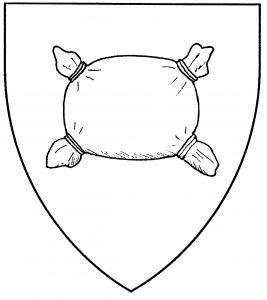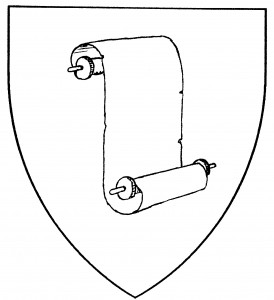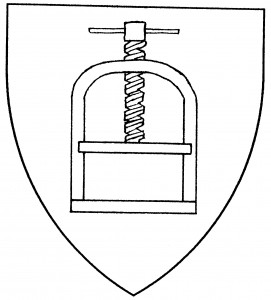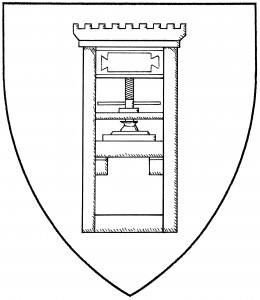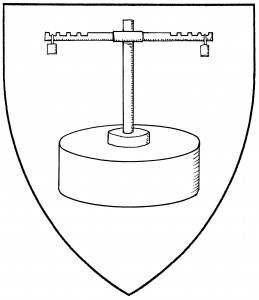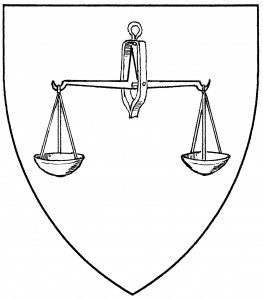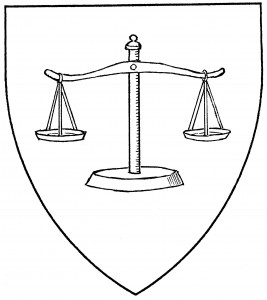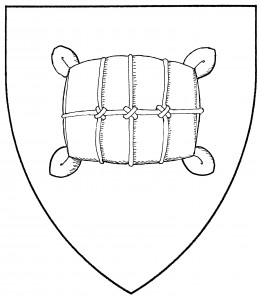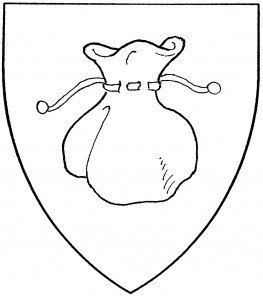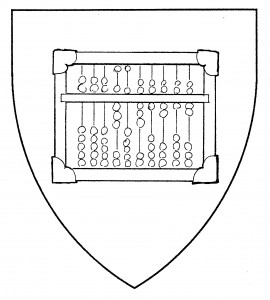Catherine Loxley of Tirnewydd bears: Per chevron sable and barry wavy argent and gules, in chief two wool-packs argent.
Kára sindri bears: Per fess vert and lozengy vert and Or, a fess and in chief a woolsack argent.
Joanna the Spinner bears as a badge: A wool-pack gules.
Archives
Scroll
A scroll is a roll of parchment or paper. The mundane heraldic scroll seems to be a simple banderole, which is also called an “escroll” (and is so blazoned in the Society). In Society armory, the term “scroll” refers to the ancient form of book (still used for some sacred texts, such as the Torah); this form of scroll has not been adduced in period armory.
A scroll may be either “closed” (rolled) or “open” (partially unrolled). As neither type is default, the type should be explicitly blazoned; open scrolls are more common in the Society. Closed scrolls always include the handled rods around which the paper is rolled; open scrolls may include the rods or not, at the artist’s discretion.
An open scroll is palewise by Society default. No default orientation has been defined for closed scrolls; the illustration shows a closed scroll palewise.
Hubert de Recoing bears: Vert, a sword bendwise sinister inverted argent, gripped and pommeled azure, between an open scroll argent handled azure and a loaf of bread proper.
Simon d’Arc the Scholar bears: Per bend sinister azure and gules, two open scrolls Or.
Na’arah bat Avraham bears: Azure, a closed Torah scroll palewise, on a chief argent three frets throughout sable.
Press
A press is an implement used to squeeze, crush or otherwise apply great pressure over a wide area. Several types of press were used as artifacts throughout period; all are acceptable in Society armory.
To date, the only form of press found in period armory is the “wine press”, with a long lever arm for crushing large quantities of grapes. The wine press (torchio in Italian) is found in the canting arms of de Torcis, mid-15th C. [Triv 347].
In Society armory, the most common form of press is the type used to crush smaller amounts of fruit or seeds; it has been variously blazoned in Society heraldry as a “screw press” or a “cider press”, but the basic form remains unchanged.
Society armory also has the “printing press”, made famous by Gutenberg c.1450 for copying words and figures onto paper. All these forms of press are upright by default.
The Royal Press Corps of the West bears: Purpure, a screw press Or.
Rhys Afalwin bears: Argent, a cider press sable between three apples gules, slipped and leaved proper.
Luciano di Challant bears: Ermine, a printing press gules.
Mill
A mill is a facility for grinding or crushing. The term usually refers to a grist mill, for grinding grain into flour: it consists of one or more large circular stones (“millstones”), mounted on an axle, and turned by wind, water, or animals. The mill is a period charge, found in the canting arms (German Mühle, “mill”) of von Uhrmuhl, 1605 [Siebmacher 98]. In this form, the axle is vertical, with a balancing beam on top. For related charges, see grindstone. See also windmill.
Leikr hrafnasveltir bears: Or, a mill sable.
Mildryth Thomaswyf bears: Gules semy of mills Or.
Eadric the Younger bears: Per chevron vert and azure, on a chevron argent three mills palewise sable.
Balance
A balance is a weighing instrument, consisting of a lever arm with two pans. Though often used in medieval commerce, it’s best known as one of the attributes of the Roman goddess Justitia (Justice), and is thus a symbol of justice and fairness.
Sometimes the balance is loosely termed “a set of scales”, though in strict fact the scales are simply the balance arm and pans alone; since scales have been registered as charges in their own right, it’s best to use the correct term.
Two forms of the balance are found in Society armory. The form found in medieval armory is the “hand balance” or “hanging balance”, with a handle to chief; it’s found in the allusive arms (Latin iustus, “just”) of di Iusti, mid-15th C. [Triv 180]. As the period form of the charge, the hanging balance is now considered the default balance for Society armory, although it’s often blazoned explicitly.
Society armory also has the “standing balance” on a pedestal, a modern symbol of the legal profession. This form is always specified in blazon. With no examples from period, either as an artifact or in period armory, the standing balance is no longer permitted for Society use.
Elena Fodor bears: Argent, three balances azure.
Marcus Parvus Constantinopolitanus bears: Gules, three standing balances argent.
Conrad Tolbert Regnault bears: Azure, a sword proper supporting on its point a pair of scales Or.
Theodore Barrister bears: Vert, a hanging balance and a chief Or.
Bag of madder
A bag of madder is a bundle of madder roots, wrapped in cloth and bound with cords for transport. It’s a period charge, found in the arms of the Worshipful Company of Dyers, c.1530 [Bromley & Child 79]. The bag of madder is fesswise by default. For related charges, see cushion, wool-pack.
Elysant d’Antioch bears: Argent, a bend sinister between a tree blasted sable and a bag of madder gules corded sable.
Nikolai Gornostai Spiach’ev bears as a badge: A bag of madder erminois.
Bag
A bag is a cloth or leather container that can be tied shut at the top, used for holding money or other small items. The most common form in Society heraldry may also be blazoned a “drawstring bag”, “sack”, or “pouch”; it is a period charge, found in the canting arms of von Sax, 1413 [Conz.Const. clxx], and of von Montsax, 1605 [Siebmacher 202]. (The prefix “string-” helps differentiate these from the basic “(wool-)bag” or “(pilgrim’s) purse” of mundane heraldry.) The bag is typically drawn filled, as in the illustration; and this is sometimes made explicit in blazon, e.g., “money-bag”.
The Society has a few examples of special-purpose bags, usually identified through context: e.g., a “bag with a harp issuant” may be assumed to be a harp-bag, a protective covering for the harp.
The term “bag” was also used in medieval blazon to denote a bundle of goods sold in commerce; for clarity’s sake, in Society blazon, the contents of the bag are explicitly blazoned, as with the bag of madder. For related charges, see scrip.
The Order of the Winged Pouch, of Insula Draconis, bears: A pouch azure winged Or.
Fabiano Figlio degli Due Sacchi bears: Per pale embattled Or and gules, two sacks, their necks tied with cords, counterchanged.
Anton von Heidelberg bears: Lozengy vert and Or, in pale an owl argent perched atop a drawstring pouch fesswise gules.
Renna of Battersea bears as a badge: A lion-posted harp fesswise reversed argent issuant from a bag erminois, lined vert. [Harp-bag]
Abacus
An abacus is a device for counting and calculating, consisting of rows of sliding beads. While similar apparati may have been used in Roman times, they’d fallen out of use by the Middle Ages, replaced by the counting table; thus no examples of the abacus have been found in period armory. The abacus used in Society armory is the form found in the Far East, called suan pan by the Chinese, soroban by the Japanese. As a non-European artifact, its use is considered a step from period practice.
The abacus is fesswise by Society default.
Walter Faversham bears: Per chevron embattled argent and vert, two wooden abacuses proper and a thunderbolt Or.
Reinhardt Breitenbach bears: Per pale gules and Or, an abacus counterchanged.
Carwyn O’Hirwen bears: Per pall Or ermined azure, sable and vert, an abacus argent.
